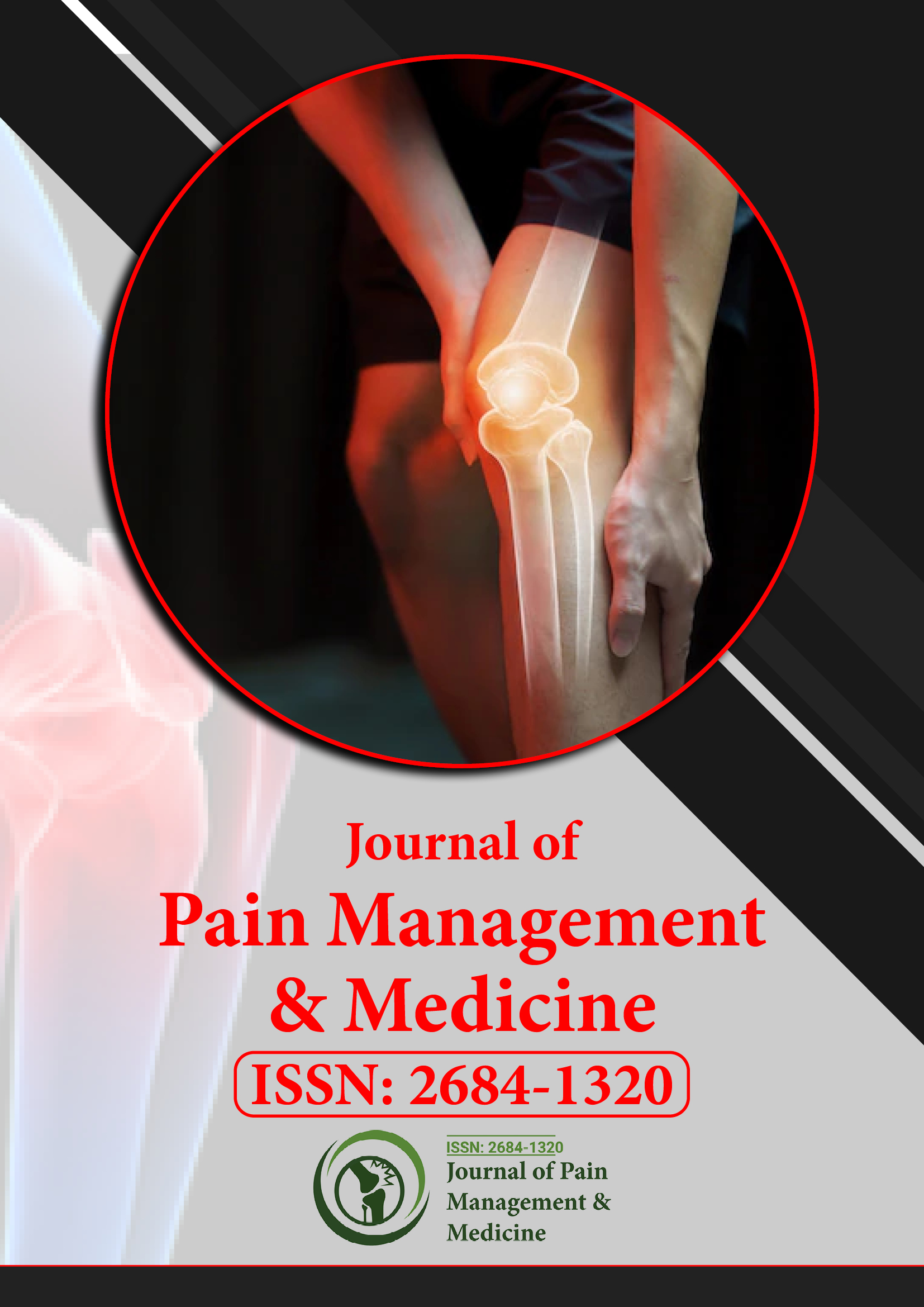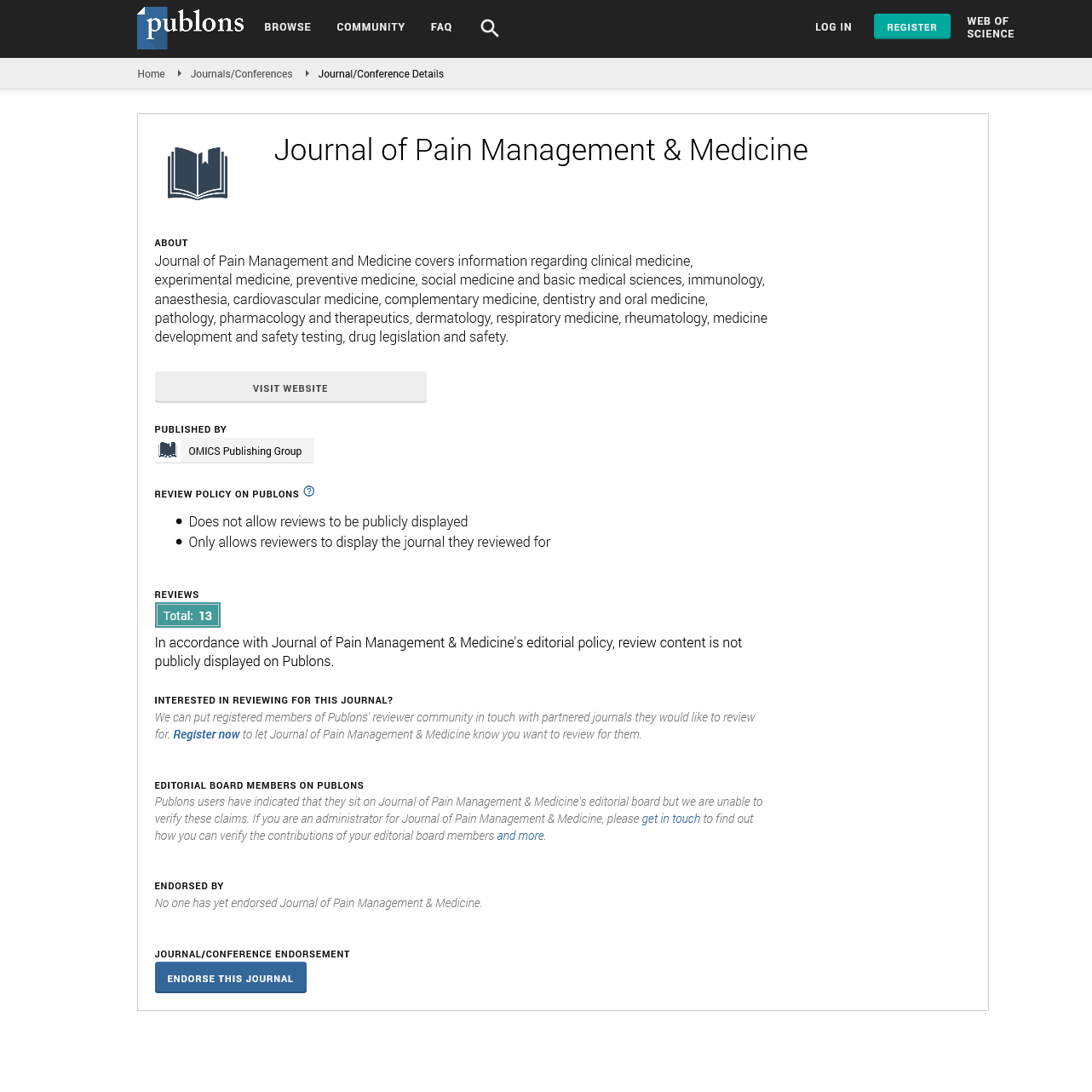Indexed In
- RefSeek
- Hamdard University
- EBSCO A-Z
- Publons
- Euro Pub
- Google Scholar
- Quality Open Access Market
Useful Links
Share This Page
Journal Flyer

Open Access Journals
- Agri and Aquaculture
- Biochemistry
- Bioinformatics & Systems Biology
- Business & Management
- Chemistry
- Clinical Sciences
- Engineering
- Food & Nutrition
- General Science
- Genetics & Molecular Biology
- Immunology & Microbiology
- Medical Sciences
- Neuroscience & Psychology
- Nursing & Health Care
- Pharmaceutical Sciences
Mini Review - (2021) Volume 7, Issue 2
Decision-Making Regarding the Administration of Pain by Clinical Attendants
Henrik Galvani*Received: 01-Mar-2021 Published: 23-Mar-2021
Abstract
Throughout the long term various endeavors have been made to improve the appraisal and the board of agony. Studies intended to comprehend the reasons basic viable torment just as mediation considers endeavoring to impact change have been led.
Keywords
Medical caretakers; Torment; Pain management
Introduction
Throughout the long term various endeavors have been made to improve the appraisal and the board of agony. Studies intended to comprehend the reasons basic viable torment just as mediation considers endeavoring to impact change have been led [1]. Consequences of exploration endeavors have prompted proposals for expanded schooling for medical caretakers and other medical care experts. Moreover, changes in enactment, monetary repayment for the treatment of torment, and alteration of perspectives toward torment the executives have been recommended. Projects dependent on these suggestions have done a lot to improve torment the board. Lamentably, a requirement for development remains. Different roads of examination may add to the current group of information and lead to all the more likely consideration for those in torment. The attendant's dynamic interaction is a region that warrants extra examination [2].
A warning gathering of five rehearsing medical attendants, two nursing workforce and one medical caretaker overseer concluded that one month was a sensible timeframe for attendants to consider what they had realized and make changes in their consideration. It was speculated that after the intercession: (1) attendants' utilization of assumptions to settle on choices in regards to the board of agony would diminish, (2) medical caretakers' documentation of their patients' torment would build, (3) torment objectives for patients as recorded by medical caretakers would diminish, (4) patients' torment levels would diminish and (5) torment related impedance with patients' movement would diminish. Stage I of the investigation was led throughout a three month timeframe. During this time attendants reacted to the agony information survey (PKQ) to decide their degree of general information comparative with torment [3]. Albeit primer information didn't show any connection between torment information and utilization of assumptions to coordinate torment the executives, absence of information may be a factor that could incline medical attendants to utilize unseemly data to settle on care choices. They additionally finished the clinical dynamic poll for torment the board (CDQPM) and a concise segment profile. Little gathering meetings were recorded and information was investigated for topics comparative with the utilization of assumptions in settling on choices in regards to the administration of agony. Records of the patients really focused on by the attendant members were audited for the accompanying data: age, analysis, sexual orientation, and length of stay. This data was utilized to look at patients when the mediation on these boundaries. Attendants' documentation of their patients' agony was likewise gathered. Despite the fact that attendants' documentation isn't especially solid, examiners accepted that documentation comparative with torment the executives would build following the intercession. It was additionally estimated that torment objectives for patients reported by medical caretakers would diminish. An examination collaborator surveyed patients' present, most noteworthy and in general torment (during their medical clinic stay) just as agony related obstruction with action. Stage II of the examination started with the intercession fourteen days post-stage I. One month following the mediation information assortment from Phase I was rehashed except for the gauge general agony information poll [4,5].
Instruments
The Pain Knowledge Questionnaire (PKQ) reflects those basic concepts that nurses need to know in order to provide effective pain management. Content validity was established by a panel of six experts in the field of pain management. Test re-test reliability of the PKQ was conducted on 26 practicing nurses over a nine day period. A reliability coefficient of .86 was calculated. Respondents circle TRUE or FALSE. The questionnaire contains 25 items such as ‘‘NSAIDs such as ibuprofen control moderate to severe pain’’ and ‘‘the rate of addiction to opioids prescribed for acute pain is extremely low’’ [3]. The Clinical Decision-Making Questionnaire for Pain Management (CDMQP) is an investigator designed instrument that instructs nurse respondents to rate on a scale of one to five the amount of time and energy they would spend managing the pain of patients described in terms of diagnosis and age (elderly) given that all patients have the same degree of pain. Content validity was established by a five-member panel of nurse experts in the field of pain management. Nine diagnostic categories plus the elderly were included in the questionnaire for this study. Diagnoses were selected based on patients generally seen on the study unit plus those categories that consistently evoked preconceived notions regarding pain management in the preliminary data (cancer, AIDS, suicide attempters, drug abusers and the elderly). Test re-tests reliability on a separate sample of 31 nurses yielded a correlation coefficient of .82. Because this one item questionnaire can be used with two or more patient categories and differing responses are expected, calculation of internal consistency was not relevant [5-8]. The evidence for the effectiveness of psychological therapies for the management of chronic pain is reviewed in this article. We provide a summary of recent secondary dataanalysesandevidencesynthesesofpsychologicaltreatmentsoffer ed for common chronic pain conditions; in particular, musculoskeletal, rheumatological, and cancer pain. We report data on adolescents and adults but we do not focus on older adults as they are the subject of a separate contribution in this volume.5Throughout, we have a concern for the quality of primary trials and the quality of the reviews. Where possible, we report evidence from a Cochrane review. Where no Cochrane review is available, we report an existing meta-analysis and, failing this, resort to the narrative review. After the evidence summary, we discuss key trends in the data and suggest areas for the improvement and development of psychological treatments. Finally, given the reality of pain practice, and inconsistent access to psychology expertise, we discuss good psychological practice for the non-psychologist.
Visual Analogue Scale
Visual Analogue Scales (VAS) (0–10) was used to collect pain levels (present, highest and overall) and pain related interference with patient activity for all patients in the study.
Intervention
A professional group facilitator was hired to meet with small groups of nurses (three groups of 5, two groups of 4) to discuss the process of decision-making relative to the management of pain. Seven brief scenarios involving patients in pain with differing diagnoses, ages, and degrees of pain provided the stimulus for discussion. The facilitator asked participants to make decisions regarding how patients would be treated for pain. She then asked them to consider the role of preconceived notions in their decisions. Discussion ensued relative to the issue of preconceived notions, how they were used, how they developed and how to bring them to nurses’ awareness. For those physicians without access to programmatic and multidisciplinary treatments, the practice of simple psychological principlesandtechniquesoffersthepossibilityofdivertingsomepatie ntsfrom the course of increasing disability.
Results
The mean score on the PKQ was 21 ± 1.8. Correlation between scores related to how much time and energy nurses would spend on managing the pain of different groups of patients and their knowledge about pain management was low and not significant.
Hypothesis 1 Nurses’ CDPMQ scores would increase following the group sessions. Nurses would be willing to spend more time and energy managing pain across all groups of patients. Supported: mean bias scores changed significantly from 3.9 ± 0.59 pre-intervention to 4.4 ± 0.66 post-intervention (t=2.43, p<.05).
Hypothesis 2 Nurses’ documentation of their patients’ pain goals would increase. Supported: A significant difference was found pre and post-intervention in documentation of pain goal met (v2= 5.6, p<0.05). Fifty-two percent of nurses documented pain goals prior to the intervention 59% following the intervention.
Hypothesis 3 Pain goals as documented by nurses would decrease. Supported: Pain goals diminished for renal disease (t=6.21, p<.002, mean pre-goal 3, post-goal 0), heart disease (t=2.5, p<.03, mean pre-goal 1.5, post-goal 0) and lung disease (t=4.02, p<.03, mean pre-goal 1.5, post-goal 0).
Hypothesis 4 Patients’ reported pain levels would decrease. Not supported: While an examination of reported pain levels following the intervention showed lower pain, the difference was not significant.
Hypothesis 5 Pain related interference with patients’ activity would decrease. Not supported: No difference was found.
Conclusion
The findings of this study contribute to our understanding of the decision-making processes for physicians and nurses around pain management. Pain management practices were clearly described by physicians and nurses, beginning with the assessment of pain and moving toward treating it using both non pharmacological and pharmacological strategies. The barriers and challenges to assessing pain often precluded optimal pain treatments as health care providers were not confident in their choices of treatment strategies, including pain medications. Physicians and nurses reported being careful in their use of pain medications, particularly around opioid use, which often limited their ability to manage pain effectively. A common goal for both nurses and physicians was to work toward an individualized approach that attempted to balance both the risks and benefits of using pain medications. People whose lives are disrupted by the occurrence and persistence of pain react as they would to any other threat, with fear and active attempts to escape or avoid it. Chronic escape and avoidance can lead to severe disability and depression. For those with complex disability, psychological treatments are well developed and evaluated.
REFERENCES
- Barnason S, Merboth M, Pozehl B, Tietzen M. Utilizing an outcomes approach to improve pain management by nurses: A pilot study. Clin Nurse Spec. 1998;12:28–36.
- Bernabei R, Gambossi G, Lapane K, Landi F, Galsones C, Dunlop R, et.al. Management of pain in elderly patients with cancer. Jama-j am med assoc. 1998;279:1877–1882.
- Bodenhausan GV, Lichenstein M. Social stereotypes and information processing strategies: the impact of task complexity. J pers soc psychol. 1987;52:871–880.
- Bodenhausen G, Wyer R. Effects of stereotypes on decision making and information-processing strategies. J Pers Soc Psychol. 1985;48:267–282.
- Brockopp DY, Warden S, Coclough G, Brockopp G. Hospice patients perspective on pain management. The Hospice Journal. 1996;11:41–53.
- Brockopp DY, Brockopp G, Warden S, Wilson J, Carpenter J, Vandeveer B. Identification of social and institutional barriers to effective management of pain in acute care institutions. Int J Nurs Stud. 1998;35:226–232.
- Brockopp DY, Ryan P, Warden S. Nurses’ willingness to manage the pain of specific groups of patients. Br j community nurs. 2003;12(7):409–415.
- Clotfelter C. The effect of an educational intervention on decreasing pain intensity in elderly people with cancer. Oncol Nurs Forum. 1996;26:27–33.
- Dahlman G, Dykes A, Elander G. Patients’ evaluation of pain and nurses’ management of analgesics after surgery. J Adv Nurs. 1999;30:866–874.
- De Rond M, De Wit R, Van Dam F, Van Campen B, Den Hartog Y, Klievink R. A pain monitoring program for nurses: effects on nurses’ pain knowledge and attitude. J Pain Symptom Manag 2000;19:457–467.
Citation: Galvani H (2021) Decision-Making Regarding the Administration of Pain by Clinical Attendants. J Pain Manage Med 7:148
Copyright: © 2021 Galvani H. This is an open-access article distributed under the terms of the Creative Commons Attribution License, which permits unrestricted use, distribution, and reproduction in any medium, provided the original author and source are credited.

